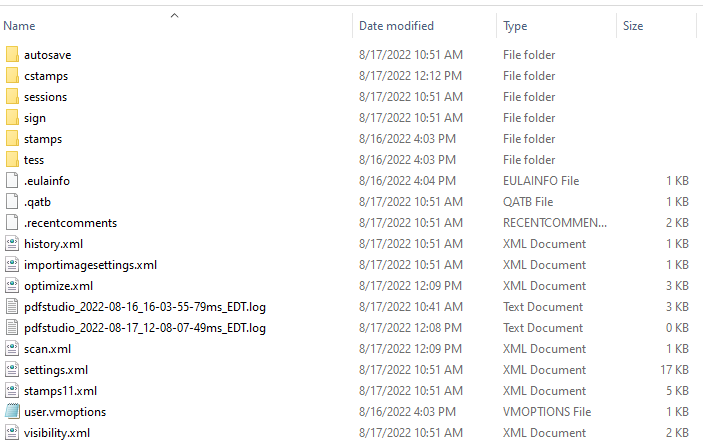Q: What and where are the settings files for PDF Studio?
A: Settings files for PDF Studio are saved in your user home folder, under a directory called .pdfstudio[version], where [version] is the version of PDF Studio you have installed.
Note: The hidden files may not be shown by default for your system. You must first make sure that you can see hidden files before you can access the settings files. See the documentation for your OS to enable displaying hidden files
PDF Studio 2023 and newer:
Starting in PDF Studio 2023, the location of PDF Studio settings files have changed. Others remain the same.
Windows: C:\Users\[Username]\AppData\Roaming\Qoppa Software\PDFStudio
Mac: /Users/[Username] /Library/Preferences/PDFStudio/
Linux: /home/[Username]/.config/PDFStudio
Where [Username] is the name of the account login
PDF Studio 2022 and older:
Windows:
Using Command Prompt
- Open a command shell: Windows + R, cmd or Start > Run > cmd
- The command prompt should open to your user directory by default. For example, C:\users\JohnSmith
- Type dir /a in the terminal window.
- You should see a folder named .pdfstudio[version] in the file list where [version] is the version of PDF Studio you have installed. For example, .pdfstudio2020
- This is where you will find the files listed below
Using File Explorer
- The folder is typically located in the primary drive where the OS is installed
- C:/Users/[username] where “username” is the name of the account login
- You should see a folder named .pdfstudio[version] in the file list where [version] is the version of PDF Studio you have installed. For example, .pdfstudio2020
- This is where you will find the files listed below
Mac and Linux:
Using Terminal
- Open a Terminal window. (On Mac, Applications > Utilities > Terminal.app) (On Linux: Ctrl + Shift + T)
- The terminal prompt should open to your user directory by default. For example, apple-ibook:~apple
- Type ls -a in the terminal window.
- You should see a folder named .pdfstudio[version] in the file list where [version] is the version of PDF Studio you have installed. For example, .pdfstudio2020
- This is where you will find the files listed below
Using Finder/File Explorer
- The folder is typically located in the primary drive where the OS is installed
- On Mac – Open Finder then go to Macintosh HD->Users->[username] where “username” is the name of the account login
- On Linux – Open File Explorer then go to the Home folder
- You should see a folder named .pdfstudio[version] in the file list where [version] is the version of PDF Studio you have installed. For example, .pdfstudio2020
- This is where you will find the files listed below
Example Files
File Names & Descriptions
Below are each of the folders and files found in the user settings directory and their descriptions.
Folders:
autosave – folder where auto save settings and temporarily files are saved
cstamps – folder where the custom stamps are saved
sessions – folder where sessions are saved
sign – folder where the user digital certificates files
stamps – folder where the image files for image stamps are saved
tess – folder where languages and settings for OCR are saved
Files:
.eulainfo – eula acceptance file
.qatb – Quick Access toolbar file
.recentcomments – contains “recent comments” under the tool chest
history.xml – contains “recent documents”
importimagesettings.xml – contains the settings when converting images to PDF
optimize.xml – contains all optimizer profiles
pdfstudio.log – log file which contains any error log. It can be viewed from PDF Studio under the Help -> About dialog (click on the pdfstudio.log link next to “View Log File”).
scan.xml – contains scan profiles
settings.xml – general settings file which contains user preferences such as annotation defaults, watermarks, headers and footers, email settings, document services, etc… All passwords are encrypted in this file.
stamps.xml – contains information about text, image and custom stamps such as name, transparency, color, etc… It also has links to the resource files located under the stamps or the cstamps directories.
.mycomments – contains “my comments” under the tool chest
emailhints – are the completion hints for the fields in the send email dialog
pscerts – certificate store for digital signatures
visibility.xml – contains the visibility settings for the icons on the toolbar: which tools is visible or hidden and which toolbar is grouped or un-grouped.

